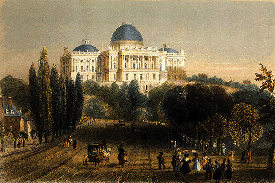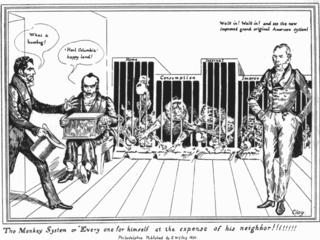 W
WThe presidency of John Quincy Adams began on March 4, 1825, when John Quincy Adams was inaugurated as President of the United States, and ended on March 4, 1829. Adams, the sixth United States president, took office following the 1824 presidential election, in which he and three other Democratic-Republicans—Henry Clay, William H. Crawford, and Andrew Jackson—sought the presidency. There was no preliminary party primary six months before the general election, as became the custom. No candidate won a majority of Electoral College votes, and so the United States House of Representatives chose the president in a contingent election. With the help of Clay, Adams was elected by the House, and Clay became Adams's Secretary of State.
 W
WThe 1827 State of the Union Address was written by John Quincy Adams, the sixth President of the United States. It was given on Tuesday, December 4, 1827, to the United States House of Representatives and United States Senate. Adams said, "A revolution of the seasons has nearly been completed since the representatives of the people and States of this Union were last assembled at this place to deliberate and to act upon the common important interests of their constituents." It was given to the 20th United States Congress.
 W
WThe inauguration of John Quincy Adams as the sixth President of the United States took place on Friday, March 4, 1825, in the House Chamber of the U.S. Capitol in Washington, D.C.. The inauguration marked the commencement of the four-year term of John Quincy Adams as President and the first term of John C. Calhoun as Vice President. Adams was the first president to have been the son of a former President–John Adams; and Calhoun, at age 42 on Inauguration Day, was the second-youngest vice president.
 W
WJohn Quincy Adams was an American statesman, diplomat, lawyer, and diarist who served as the sixth president of the United States, from 1825 to 1829. He previously served as the eighth United States Secretary of State from 1817 to 1825. During his long diplomatic and political career, Adams also served as an ambassador, and as a member of the United States Senate and United States House of Representatives representing Massachusetts. He was the eldest son of John Adams, who served as the second US president from 1797 to 1801, and First Lady Abigail Adams. Initially a Federalist like his father, he won election to the presidency as a member of the Democratic-Republican Party, and in the mid-1830s became affiliated with the Whig Party.
 W
WThe American System was an economic plan that played an important role in American policy during the first half of the 19th century. Rooted in the "American School" ideas of Alexander Hamilton, the plan "consisted of three mutually reinforcing parts: a tariff to protect and promote American industry; a national bank to foster commerce; and federal subsidies for roads, canals, and other 'internal improvements' to develop profitable markets for agriculture". Congressman Henry Clay was the plan's foremost proponent and the first to refer to it as the "American System".
 W
WThe history of U.S. foreign policy from 1801 to 1829 concerns the foreign policy of the United States during the presidential administrations of Thomas Jefferson, James Madison, James Monroe, and John Quincy Adams. International affairs in the first half of this period were dominated by the Napoleonic Wars, which the United States became involved with in various ways, including the War of 1812. The period saw the United States double in size, gaining control of Florida and lands between the Mississippi River and the Rocky Mountains. The period began with the First inauguration of Thomas Jefferson in 1801. The First inauguration of Andrew Jackson in 1829 marked the start of the next period in U.S. foreign policy.
 W
WFollowing is a list of all Article III United States federal judges appointed by President John Quincy Adams during his presidency. In total Adams appointed 12 Article III federal judges, including 1 Justice to the Supreme Court of the United States and 11 judges to the United States district courts.
 W
WThe 1824 United States presidential election was the tenth U.S. presidential election. It was held from Tuesday, October 26 to Wednesday, December 1, 1824. Andrew Jackson, John Quincy Adams, Henry Clay and William Crawford were the primary contenders for the presidency. The result of the election was inconclusive, as no candidate won a majority of the electoral vote. In the election for vice president, John C. Calhoun was elected with a comfortable majority of the vote. Because none of the candidates for president garnered an electoral vote majority, the U.S. House of Representatives, under the provisions of the Twelfth Amendment, held a contingent election. On February 9, 1825, John Quincy Adams was elected as president.